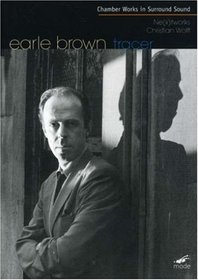| Genres: Music Video & Concerts, Musicals & Performing Arts Sub-Genres: DTS, Classical Studio: Mode Format: DVD - Color,Widescreen - Closed-captioned,Subtitled DVD Release Date: 05/08/2007 Original Release Date: 05/08/2007 Theatrical Release Date: 08/06/2007 Release Year: 2007 Run Time: 1hr 51min Screens: Color,Widescreen Number of Discs: 1 SwapaDVD Credits: 1 Total Copies: 0 Members Wishing: 1 Edition: Classical MPAA Rating: NR (Not Rated) Subtitles: English, French, German |
Search - Earle Brown: Chamber Works on DVD
  | Earle Brown Chamber Works Genres: Music Video & Concerts, Musicals & Performing Arts NR 2007 1hr 51min The first DVD release of Earle Brown's music Features include: Interview with Brown's widow Susan Sollins, Ne(xt)work's director Cornelius Dufallo (also Brown's godson), and Earle Brown Foundation's Micah Silver on the wor... more » |
Larger Image |
Movie Details |
Movie ReviewsWonderful playing of difficult music to conceive scarecrow | Chicago, Illinois United States | 09/23/2007 (5 out of 5 stars) "All the playing here is wonderful, very intelligent conceptions of how the music should proceed. How does one play graphic notation?
Brown's arduous graphic works are rather difficult to play, you simply cannot say there is no wrong way to play this music wallowing in the ignorance of Zen simplicity; you are very wrong; music should be interesting, compelling, inspirational,fascinating,illuminating, no matter what is in front of you. Brown became disgusted with the performances of his music around the late Fifties continuing into the present. John Cage has been known to walk out on his own music if the performers were merely FF-ing around.There is a lot of this neo-liberal freedoms that even today:Around the late Fifties Brown began strenauously coaching and advising all performances of his music, at least the ones he knew about.He continued this mentorship where his notational systems became more determined. The innovative graphic music was the early Fifties as represented herein within the mileau of Abstract Expressionism, Brown felt he needed to foster a musical equivalent.Really this was the high moments for there was little afterwards.Brown like everyone else became more magnetized toward the accessible moments within the avant-garde. Perhaps he never had a good PR person. His musical language/philosophy was somewhere in between total construction and pure freedom.When tones are given for example(sometimes quite arbitrary in shape) you are simply required to play those tones in the order you yourself choose, but then you cannot add any tones yourself, and they must played within a certain period of time. Brown was interested in the techniques of pitch construction, serial music,its implications and the science of tone configurations, certainly more than his innovative Brethren, Cage, Feldman and Wolff.Although like any aesthetic signifying experience(a School) all contributed to the same language in their own unique ways. . . . Brown's genius was that he chose to follow his instincts, allowing the enigmatic beautiful graphic pieces to speak fro themselves, as "December", and "Four Systems", well all these early Fifties graphics have some interesting timbral content to represent in space, in time, in sound, in shape. I wonder if one can come now to speak of an evolution of graphic notation? because it simply died a slow death, after the high moments of the Cage,less so Feldman,then Brown and Wolff prior to his politicalization.The more fascinating aspects of graphic notation metamorphosized into to the more social political strains as,improvisation, Cardew the Scratch Orchestra,AMM,also Stockhausen's group where relevance became redefined an anti-elitism,more accesible product was favored over merely performing music cold abstractions for millionaires at New York's finest galleries. I've heard some pretty awful boring performances of graphic music however no matter who writes it and by gifted improvisors/creators in their own rights.Perhaps that is something of the past tense. If you think graphic notation is simply a impetus to do anything, you're wrong!, and here like in the playing of "tracer", the playing is well balanced mindful of each others part, and an interesting use of extended techniques for the strings. The agenda here for most of these pieces was to create a plan of performance, you feel this while listening, that the music is moving along a thread, of gesture, of registral place, of timbre, leaving room for everyone to be heard. There seems to be some kind of ground bass of some sort at work here, as the piano in "March, quarter is 87", and the Vibes come off the piano somewhat preditable pulse indeterminately. Anyway this is the best Brown I've heard in quite some time." |

